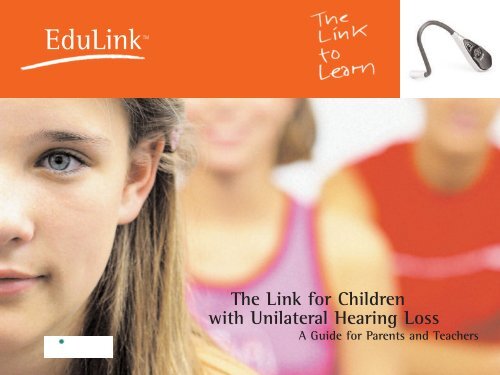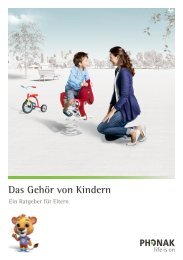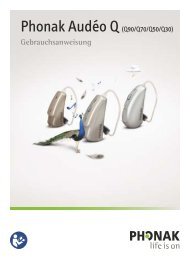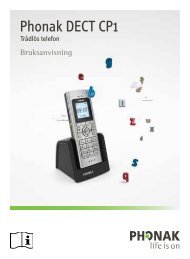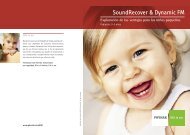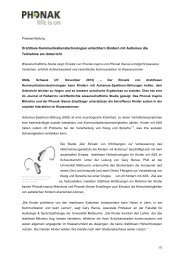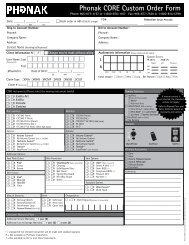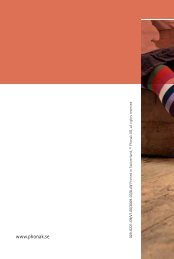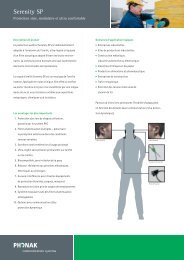EduLink - Phonak
EduLink - Phonak
EduLink - Phonak
Create successful ePaper yourself
Turn your PDF publications into a flip-book with our unique Google optimized e-Paper software.
PHO000464ADen:PHO000464ADen 03.03.2008 18:05 Seite 1<br />
<strong>EduLink</strong>TM<br />
The Link for Children<br />
with Unilateral Hearing Loss<br />
A Guide for Parents and Teachers
PHO000464ADen:PHO000464ADen 03.03.2008 18:05 Seite 2<br />
“When our daughter was diagnosed with<br />
Unilateral Hearing Loss, we felt sad and relieved.<br />
Things made sense now. It hadn’t been about<br />
being disruptive, non-compliant or mischievous –<br />
she just hadn’t heard or understood…”<br />
Daniel Maitland, parent of Kim<br />
Introduction<br />
If you are reading this brochure, you probably know someone with<br />
Unilateral Hearing Loss. This person may be your child or your<br />
grandchild, your (little) brother or sister, a child or student in your<br />
classroom or one of your friends.<br />
Maybe that person has only recently been diagnosed with<br />
Unilateral Hearing Loss and you feel confused and have many<br />
questions to ask. It is important to know that you are not<br />
alone. Many others have had feelings and anxieties. And they<br />
have looked for answers to their questions.<br />
This brochure addresses Unilateral Hearing Loss, the difficulties it<br />
may cause and <strong>EduLink</strong>, an FM receiver specifically designed for<br />
children who have some degree of normal hearing, but difficulties<br />
understanding in the classroom. Also included is a board game<br />
which you can play as a family, in class, in groups or among friends<br />
to address the topic of hearing loss and some of its issues.<br />
It may be that you have known about the Unilateral Hearing Loss<br />
for some time already and, for some reason, now is the right<br />
time to find out more about what possible technological solutions<br />
are available to reduce some of the difficulties.<br />
2
PHO000464ADen:PHO000464ADen 03.03.2008 18:05 Seite 3<br />
Hearing loss: an invisible filter<br />
Any type and degree of hearing loss presents a barrier to a child’s<br />
ability to receive information and learn from his or her<br />
environment. As a consequence, if children are able to hear<br />
and understand well, they will be able to communicate<br />
and acquire knowledge. However, if a hearing loss filters out<br />
valuable and accurate information, the child will not have<br />
optimum access to language. This will influence his or her ability<br />
to develop speech and language skills, the foundation for later<br />
reading and academic skills.<br />
Children, by their very nature, are more at risk than adults<br />
in noisy environments, because they bring a different listening<br />
ability to a situation. On the one hand, they do not have<br />
a complete neurological system, meaning their auditory nervous<br />
system continues to mature and specialize until their<br />
mid-teens. As a result of this, children do not have the same<br />
skills as adults to process speech and background noise<br />
at the same time, which explains why also in real life, children have<br />
more difficulties understanding speech in noisy environments<br />
(on the street, at parties, in the classroom etc.). On the other hand,<br />
they also lack the years of language and life experience that<br />
enable adults to fill in the gaps when part of a message cannot be<br />
heard – e.g. when surrounding noise smears the speech signal,<br />
when a hearing loss filters part of the message out or when speech<br />
gets too soft over a greater distance.<br />
But what is a hearing loss? And how do hearing care professionals<br />
define it? What are short- and long-term disadvantages that<br />
come with it?<br />
Professionals usually define a hearing loss in words and<br />
in numbers.<br />
3
PHO000464ADen:PHO000464ADen 03.03.2008 18:05 Seite 4<br />
“Knowing the degree and type of a hearing loss is<br />
crucial. Equally important, however, is finding out<br />
more about the child’s functional hearing skills.”<br />
Erika Lowrie, audiologist<br />
Hearing Loss in Words…<br />
…to describe the degree and type of hearing loss<br />
Conductive<br />
Sensorineural<br />
The degree of a hearing loss is classified as mild, moderate,<br />
severe or profound.<br />
Outer Ear<br />
Middle Ear<br />
Ossicles<br />
Inner Ear<br />
Cochlea<br />
Auditory nerve<br />
There are 3 different types of hearing loss, depending on<br />
Pinna<br />
the location of the damage (site of lesion) in the auditory system:<br />
■<br />
A conductive hearing loss results from an abnormality in<br />
the outer or middle ear. This type of hearing loss causes a decrease<br />
in loudness perception or a loss of loudness. Sounds are no<br />
Ear canal<br />
longer loud enough to be heard well. This can be a permanent<br />
■<br />
or temporary condition.<br />
A sensorineural hearing loss originates in the inner ear.<br />
Ear drum<br />
It leads to a decrease in loudness as well as in clarity perception.<br />
Generally, there is no medical or surgical means to correct<br />
Eustachian tube<br />
a sensorineural hearing loss. However, today’s hearing technology<br />
Figure 1 shows the three parts of the ear<br />
can provide valuable support.<br />
■<br />
A mixed hearing loss is a hearing loss that has both a conductive<br />
and a sensorineural component.<br />
4
PHO000464ADen:PHO000464ADen 03.03.2008 18:05 Seite 5<br />
Hearing Loss in Numbers…<br />
Low Pitched Frequency in Hertz<br />
High Pitched<br />
…to specify the amount of hearing loss<br />
125 250 500 1000 2000 4000 8000<br />
Hearing loss is measured in decibels (dB). A hearing test, called<br />
puretone audiometry, records the level of hearing (measured in dB)<br />
at different frequencies (e.g. low and high pitch sounds).<br />
Normally, each ear is tested separately. For each frequency,<br />
0<br />
10<br />
20<br />
Fridge<br />
Library<br />
Birds<br />
Normal Hearing<br />
(up to 20dB ISO)<br />
the audiologist will note the lowest audible dB level (corresponding<br />
to the softest stimulus for that specific frequency) on an audiogram.<br />
Connecting these responses forms the (left and right ear)<br />
hearing thresholds. The average dB level for each ear will give<br />
the degree of hearing loss for that ear.<br />
If a person has a hearing loss in both ears,<br />
we call this a “bilateral hearing loss”.<br />
If a person has a hearing loss in one ear only,<br />
we call this a “Unilateral Hearing Loss”.<br />
Hearing Level in Decibels<br />
30<br />
40<br />
50<br />
60<br />
70<br />
80<br />
90<br />
Motor bike<br />
Conversation<br />
Vacuum cleaner<br />
Crickets<br />
Personal stereo<br />
(maximum volume)<br />
Mild Hearing Loss<br />
(20-45dB ISO)<br />
Moderate Hearing Loss<br />
(45-60dB ISO)<br />
Moderately Severe<br />
Hearing Loss<br />
(60-75dB ISO)<br />
Severe Hearing Loss<br />
(75-90dB ISO)<br />
Figure 2. shows an example of an audiogram.<br />
By copying your child’s test results on this audiogram, you<br />
can easily find out the degree of hearing (loss) of your<br />
child for each ear and which sounds he or she may be having<br />
difficulties with.<br />
100<br />
110<br />
120<br />
Jack hammer<br />
Band<br />
Jet aircraft<br />
(at 25m)<br />
Profound Deafness<br />
(90+dB ISO)<br />
Threshold of pain<br />
*Reproduced with permission from Australian Hearing<br />
5
PHO000464ADen:PHO000464ADen 03.03.2008 18:05 Seite 6<br />
“Because of the Unilateral Hearing Loss, he often<br />
seemed “disconnected”. We needed to address<br />
some things more systematically, which our other<br />
children had learned almost automatically.”<br />
Sandra Lennox, parent of Barry<br />
The Child with Unilateral Hearing Loss<br />
A child is diagnosed with “Unilateral Hearing Loss” (UHL) when<br />
he or she has normal hearing in one ear – with average hearing<br />
thresholds ranging between -10 and +15 dB HL – and at least<br />
a mild permanent hearing loss in the other ear. The degree of hearing<br />
loss in the affected ear can range from mild to profound.<br />
The word “unilateral” stems from Latin. It combines “unus”,<br />
which means “one”, with “latus”, which means “side”.<br />
Some professionals, inaccurately, refer to a Unilateral Hearing Loss<br />
as a “one-sided deafness”. The term “deafness” should only<br />
be used when the hearing loss is in the profound range.<br />
When a person’s hearing loss is in the mild to severe range,<br />
we use the term “hard of hearing”.<br />
We know from stereo recordings that by using two microphones,<br />
we can create a more natural and lively sound. Hearing also<br />
functions “stereo”-wise. The hearing centers of the brain rely on two<br />
independent “microphones” – the ears – for optimal sound<br />
processing. If only one ear is functioning properly, sounds will sound<br />
softer and one will have difficulty understanding speech in noisy<br />
environments and localizing sound. This is because we need and use:<br />
■<br />
■<br />
■<br />
■<br />
Two ears to distinguish speech from noise<br />
Two ears to locate the origin of a sound<br />
Two ears to hear at the appropriate loudness<br />
Two ears to hear naturally and clearly<br />
Without the proper functioning of two ears, a child with<br />
Unilateral Hearing Loss (UHL) can be at risk for academic,<br />
speech-language, social and emotional problems, often requiring<br />
additional support to address his or her needs.<br />
And remember, your child is not alone… Around 8 million children<br />
in the world have a Unilateral Hearing Loss.<br />
6
PHO000464ADen:PHO000464ADen 03.03.2008 18:05 Seite 7<br />
In general, a child with Unilateral Hearing Loss<br />
will have difficulties:<br />
■<br />
■<br />
■<br />
■<br />
■<br />
Hearing soft or distant speech<br />
Hearing where a sound comes from<br />
Finding the person speaking right away<br />
Keeping track of who is talking when two or more people<br />
are talking to each other<br />
Hearing specific sounds<br />
The effect is greater for children with a UHL in the right ear<br />
than for children with the loss in the left ear. The right ear<br />
is predominantly connected to the left part of the brain,<br />
where most of the speech and language functions are located.<br />
The child with UHL will also have difficulties understanding when<br />
spoken to on the affected side.<br />
7
PHO000464ADen:PHO000464ADen 03.03.2008 18:05 Seite 8<br />
Classroom Learning at Risk<br />
Classrooms are known to be noisy environments. The noise often<br />
“smears” the teacher’s voice, which – although still audible –<br />
will no longer be intelligible.<br />
Studies have shown an FM system is the only audiological<br />
recommendation that produces the highest speech understanding<br />
scores in both quiet and noise.<br />
In mainstream classrooms, hearing and listening are the cornerstones<br />
of learning. If a child cannot hear the teacher clearly,<br />
this will automatically influence the child’s learning and academic<br />
success.<br />
Children with Unilateral Hearing Loss benefit greatly from<br />
an FM system in environments where noise may interfere<br />
with learning. Such as in school, at home, on outings, in the car<br />
or even at the zoo.<br />
Children with Unilateral Hearing Loss are at risk for academic<br />
difficulties. According to some studies, at least 35% of<br />
all children with Unilateral Hearing Loss fail one grade or more.<br />
The invisible filter of the Unilateral Hearing Loss distorts,<br />
smears or eliminates incoming sounds. This can interfere with<br />
the development of a child’s spoken language, reading and<br />
writing skills and – finally – academic skills.<br />
In ideal situations, background noise should not exceed levels<br />
of 35 dB. However, in most typical classrooms, levels as high as<br />
65 dB or more have been measured. Noise sources may<br />
be other pupils talking, a fan or air conditioner, paper rustling,<br />
chairs moving, hallway, street or playground noises.<br />
As all children spend much of their day engaged in listening<br />
activities, they need clear and consistent access to spoken<br />
instruction. This will provide the best opportunities for learning<br />
over distance and in background noise.<br />
8
PHO000464ADen:PHO000464ADen 03.03.2008 18:05 Seite 9<br />
“Since she is using her FM system, Ellen has<br />
caught up dramatically. And even in our smaller<br />
sessions, I have found great use for the system.”<br />
Frances Hawthorn, remedial teacher<br />
dB<br />
80<br />
70<br />
60<br />
50<br />
40<br />
A<br />
Teacher‘s voice<br />
Background noise<br />
0 1 2 4 6<br />
Distance (meters)<br />
Figure 3. The teacher’s voice gets softer with increasing distance. Background noise<br />
is equally loud over the classroom and can reach levels up to 65 dB and higher.<br />
B<br />
As figure 3 shows, only at the very front of the classroom will<br />
the teacher’s voice be strong enough to rise above the background<br />
noise, and only there a clear audible and intelligible signal can be<br />
guaranteed. For most children, however, the speech signal is softer<br />
than the background noise.<br />
The signal-to-noise ratio (SNR) refers to the difference between<br />
the level in dB of the signal and the level in dB of the noise.<br />
At point A, the teacher’s voice has a signal level of 80 dB and<br />
background noise reaches a level of 65 dB. This results in a SNR<br />
of +15 dB where speech is clearly distinguishable from noise.<br />
At point B, less than 4 m from the teacher, the teacher’s voice<br />
has a 55 dB loudness level while background noise is still at 65 dB.<br />
The SNR at this point is -10 dB with noise obstructing<br />
the intelligibility of speech.<br />
9
PHO000464ADen:PHO000464ADen 03.03.2008 18:05 Seite 10<br />
“With the FM system, I can hear the teacher’s<br />
voice clearly and learning has become so much<br />
easier. Especially in areas where I am having<br />
difficulties – in science and during spelling tests.”<br />
Karen Jarvis, student<br />
The Direct Link between Teacher and Student<br />
In the past, audiologists and ear-nose-and-throat physicians were<br />
hardly concerned over a child’s Unilateral Hearing Loss and usually<br />
told parents “not to worry”.<br />
Today, children with Unilateral Hearing Loss are monitored closely.<br />
They are seen regularly for audiological evaluation to monitor<br />
both the good ear and also the worse ear. When necessary,<br />
they are enrolled in comprehensive management programs including:<br />
1 Direct remediation of specific skills the child has difficulties<br />
with (e.g. with regard to speech-language, audition)<br />
2 Training of compensatory strategies, teaching the child to look<br />
for cues or alternatives to better understand (making use<br />
of context, rephrasing, using visual cues)<br />
3 Environmental modifications such as acoustic classroom<br />
modifications and the use of wireless communication<br />
technology such as a personal FM system.<br />
Children with Unilateral Hearing Loss typically need a signalto-noise<br />
ratio (SNR) of +15 dB to +20 dB in the classroom.<br />
Evidence shows that preferential seating or speaking with a loud<br />
voice to increase the acoustic advantage are ineffective and<br />
cannot guarantee satisfactory SNR values. Only FM systems remain<br />
the effective way of increasing speech understanding in<br />
background noise and over distance.<br />
FM is a wireless communication technology used in a variety<br />
of applications (cordless telephones, two-way radios, baby alarms,<br />
wireless headsets, etc). An FM system consists of a transmitter,<br />
which picks up the teacher‘s voice at the mouth and sends it<br />
via radio waves and an FM receiver, which delivers the signal to<br />
the ear.<br />
10
PHO000464ADen:PHO000464ADen 03.03.2008 18:05 Seite 11<br />
It has been proven that children with Unilateral Hearing Loss perform<br />
significantly better with an FM system, and their word recognition<br />
improves significantly in both quiet and noisy situations.<br />
In the past, personal FM systems were bulky and far from practical.<br />
Parents, teachers and children reported how body-worn systems<br />
were stigmatizing the children wearing the device and how<br />
occluding earphones made participation in class extremely difficult.<br />
Additionaly, we know from professional experience that,<br />
for many children with hearing loss, sound-field systems do not<br />
deliver the best SNR and therefore don’t always improve<br />
performance in the classroom.<br />
Evidence shows that, with the right kind of FM solution,<br />
clear benefits in noise, reverberation and over distance can be achieved.<br />
■<br />
■<br />
■<br />
■<br />
■<br />
■<br />
Increased attention<br />
Optimal spoken language understanding<br />
Higher academic achievement<br />
More consistent on-task behavior<br />
Maximum speech understanding in noise<br />
Improvement in classroom behavior<br />
<strong>EduLink</strong> by <strong>Phonak</strong> was developed specifically to address these<br />
issues. Its design and functionality are based on the results<br />
of clinical and scientific studies. It provides the necessary SNR<br />
in a package designed for maximum wearing comfort and optimum<br />
speech understanding at all times.<br />
11
PHO000464ADen:PHO000464ADen 03.03.2008 18:05 Seite 12<br />
<strong>EduLink</strong> – the Link to Learn<br />
<strong>EduLink</strong> is a miniaturized FM receiver designed specifically<br />
for children with normal hearing thresholds and a normal<br />
range of comfort who have difficulties understanding language<br />
and learning in background noise and over distance.<br />
<strong>EduLink</strong> is used to complement existing therapies and it<br />
ensures that important information reaches the ear as a priority –<br />
up to 20 dB louder than the environmental noise.<br />
<strong>EduLink</strong> enables the child to hear the teacher’s voice at any<br />
time without difficulty – even in the most challenging listening<br />
situations. <strong>EduLink</strong> helps the child hear all speech sounds more<br />
clearly and train his or her auditory and language skills in-depth.<br />
<strong>EduLink</strong> is typically fit on the good ear, when the impaired ear<br />
has a moderately severe to a profound hearing loss. For other<br />
degrees of hearing loss, the hearing care professional may decide<br />
to use a different approach.<br />
Thousands<br />
of children<br />
in the world are<br />
wearing <strong>EduLink</strong> already,<br />
in the<br />
classroom<br />
and at home.<br />
12
PHO000464ADen:PHO000464ADen 03.03.2008 18:05 Seite 13<br />
“I really like <strong>EduLink</strong>. I can hear the teacher<br />
better and my friends think it is really cool.”<br />
Julian Kruger, student<br />
The microphone picks up the teacher’s<br />
voice at the mouth where the sound<br />
is still loud and clear. The Campus SX<br />
transmitter sends this speech signal via<br />
radio waves directly to the <strong>EduLink</strong><br />
receiver on the student’s ear.<br />
With an inconspicuous <strong>EduLink</strong> receiver<br />
worn on the normal hearing ear,<br />
the child can always hear the teacher’s voice<br />
loud and clear.<br />
The teacher carries a small FM transmitter<br />
and a microphone. The ultra lightweight<br />
MicroBoom has an ingenious design<br />
and offers optimum wearer comfort and<br />
the best signal-to-noise ratio.<br />
<strong>EduLink</strong> features a contemporary design,<br />
similar to the latest cell phone headsets.<br />
This guarantees acceptance by the child<br />
wearing the device as well as by other<br />
children in the class. <strong>EduLink</strong> is compatible<br />
with all <strong>Phonak</strong> transmitters.<br />
13
PHO000464ADen:PHO000464ADen 03.03.2008 18:05 Seite 14<br />
“Because of Sarah’s Unilateral Hearing Loss,<br />
we looked at what we could do to help in terms<br />
of reducing disturbing behaviors. This has<br />
improved the learning atmosphere in our classroom<br />
dramatically for all of us.”<br />
John Hiller, teacher<br />
Listening and Learning Tips<br />
These tips address some general communication aspects as well<br />
as suggestions for optimal <strong>EduLink</strong> use.<br />
<strong>EduLink</strong> proves to be excellent in any situation where background<br />
noise, reverberation or distance cause the speech signal to be<br />
less clear. The following may be considered typical <strong>EduLink</strong> situations:<br />
classroom learning, family or school outings, watching television,<br />
dinner table conversations, bicycle or hiking trips etc. In addition,<br />
because of its output limiting system, <strong>EduLink</strong> will guarantee<br />
listening safety for the normal hearing ear – transforming all<br />
incoming sounds to acceptable loudness levels.<br />
When you and your child, student or friend are not wearing<br />
the FM system:<br />
■<br />
■<br />
Always approach and speak to the child on the good-ear side;<br />
Reduce or move away from background noise. Create awareness<br />
in school and at home to allow communication in as<br />
noise-free an atmosphere as possible;<br />
■<br />
■<br />
■<br />
Speak clearly at a maximum distance of 3 to 6 feet of<br />
distance (1-2 meters);<br />
Do not overarticulate. Exaggerating your mouth movements<br />
distorts the sounds of speech and the speaker’s face,<br />
making the use of visual cues more difficult;<br />
Be aware that it is normal for the child or student to feel<br />
fatigued after classes, since he or she must work harder<br />
to keep up with the information presented.<br />
For optimal listening and learning, the following communication<br />
strategies may prove to be very helpful for your child,<br />
student or friend:<br />
■<br />
■<br />
■<br />
Watch the speaker, even if you find listening to be relatively<br />
easy – visual cues from the face and mouth provide valuable<br />
extra information;<br />
Ask the speaker for more details or to rephrase when you<br />
did not understand everything;<br />
Make use of context cues.<br />
14
PHO000464ADen:PHO000464ADen 03.03.2008 18:05 Seite 15<br />
Start here<br />
15
PHO000464ADen:PHO000464ADen 03.03.2008 18:05 Seite 16<br />
LOCALIZING A SOUND:<br />
■<br />
■<br />
■<br />
■<br />
■<br />
■<br />
For this activity, the player is blindfolded.<br />
The hearing player closes one ear with his/her finger.<br />
The partner player stands, sits or lies down somewhere<br />
in the room the player is in. For variation:<br />
the partner player changes to another room.<br />
The partner player can speak or hum at a normal voice<br />
level. For variation: background noise (such as<br />
the radio playing, the vacuum cleaner switched on)<br />
can be added.<br />
The player tries to identify the location of the partner<br />
player as precisely as possible.<br />
If this grid activity is too difficult, the child<br />
with UHL may ask someone for help.<br />
■ The player tries to guess the word<br />
■ If a player has too much difficulty with this task:<br />
the partner player or other players involved may give<br />
a tip or hint<br />
ROLL THE DIE AGAIN AND PROCEED THE NUMBER<br />
OF SQUARES INDICATED BY THE DIE<br />
ROLL THE DIE AGAIN AND GO BACK THE NUMBER<br />
OF SQUARES INDICATED BY THE DIE<br />
TAKE A BREAK AND WAIT FOR YOUR NEXT TURN TO ROLL<br />
THE DIE AGAIN<br />
UNDERSTANDING OVER DISTANCE AND<br />
IN BACKGROUND NOISE:<br />
■ For this activity, the player is blindfolded.<br />
■ The hearing player closes one ear with his/her finger.<br />
■ The partner player stands, sits or lies down somewhere<br />
in the room the player is in. For variation: the partner<br />
player changes to another room.<br />
■ The partner player speaks a sentence (approx. 4–5 words)<br />
at a normal voice level. Soft background noise<br />
(such as the radio playing softly or two or more other<br />
players softly repeating saying “rubbadubbah”).<br />
■ The player repeats the sentence spoken by the partner<br />
player as pricesely as possible<br />
■ When this challenge is too difficult, the partner player<br />
may give hints or tips for more clues.<br />
RECOGNIZING A SONG:<br />
■ Ask your game partner to hum a song and try to guess<br />
which one it is.<br />
TAKE A LONGER BREAK AND SKIP A TURN<br />
QUIZ QUESTIONS: THE PARTNER PLAYER MAY SELECT<br />
ONE OF THE QUESTIONS LISTED BELOW.<br />
■ What is a “decibel”?<br />
■ Name one thing a child with Unilateral Hearing Loss<br />
will have difficulties with<br />
■ Give an example of a soft sound<br />
■ Give an example of a loud sound<br />
■ What is an FM system?<br />
■ Name one thing you and your child, student,<br />
brother/sister or friend can do when you are not wearing<br />
the FM system?<br />
■ Approximately, how many children all over the world<br />
have Unilateral Hearing Loss?<br />
■ Why are students with Unilateral Hearing Loss at risk<br />
in the classroom?<br />
LIP-READING:<br />
■<br />
The partner player carefully selects a word. Remember:<br />
words with more than 1 or 2 syllables are easier, so are<br />
words containing more visible sounds with articulation<br />
more in the front of the mouth, (e.g. m, th, l, f, p/b,…)<br />
or more “extreme” articulation (e.g. a, o, ee,…).<br />
Starter words: elephant, potato, rainbow, teddy bear<br />
■<br />
■<br />
The player closes both ears<br />
The partner player whispers the word<br />
16
PHO000464ADen:PHO000464ADen 03.03.2008 18:05 Seite 17<br />
Let’s play!<br />
This board game can be played with family, in class or with friends.<br />
It addresses hearing loss and related issues in a different way.<br />
As with all games, you can invent your own rules and add-on<br />
activities. For “starters”, we have included some practical<br />
guidelines on how to play.<br />
What you need:<br />
■<br />
■<br />
■<br />
■<br />
■<br />
This game board<br />
A token for each player<br />
One die<br />
A blind fold<br />
Your fun self in a playing mood…<br />
Start-up and winner rules:<br />
Each player starts with a token in the starting square. The child<br />
or student with Unilateral Hearing Loss can decide on who can<br />
start this game. Players take turns to roll the die and to move<br />
their tokens by the number of squares indicated by the die roll.<br />
Activities, quiz questions or surprise elements have been included<br />
in each grid. Carefully select your “partner player”, the person<br />
who will perform the challenge you must solve. When a player<br />
succeeds, (s)he can roll the die again at the next turn.<br />
If not, (s)he will have to play this game again. The winner<br />
is the player whose token reaches the last square of track first.<br />
Whether a player must roll the exact number to reach<br />
the final square and win is up to you.<br />
17
PHO000464ADen:PHO000464ADen 03.03.2008 18:05 Seite 18<br />
<strong>EduLink</strong>TM<br />
Improving Learning and Understanding<br />
■<br />
■<br />
■<br />
■<br />
■<br />
Children with Unilateral Hearing Loss can rely on one ear only<br />
Because of this, they will have difficulties understanding<br />
in challenging listening situations such as in the classroom<br />
or in conversations involving several people<br />
This endangers classroom learning and can put the child at risk<br />
for academic, speech-language, social and emotional problems<br />
An enhancement of the signal-to-noise ratio by 15 to 20 dB<br />
as part of existing therapies will provide the child optimum access<br />
to the speech signal<br />
<strong>EduLink</strong> represents an attractive and effective way of increasing<br />
speech understanding in background noise and over distance<br />
More information on <strong>EduLink</strong> is available on the internet:<br />
www.phonak.com/<strong>EduLink</strong> and www.eSchoolDesk.com<br />
The <strong>Phonak</strong> Group specializes in the design, development, production<br />
and worldwide distribution of technologically advanced hearing systems.<br />
The combination of expertise in hearing technology and a strong<br />
distribution network allows <strong>Phonak</strong>, along with its customers<br />
and business partners, to make a substantial improvement in the quality<br />
of individuals with hearing impairment.<br />
With a market share of 88% worldwide, the <strong>Phonak</strong> Group is the major<br />
player for wireless communication in the hearing health care market.<br />
028-0192-02/V1.00 2007 03/visu‘l Printed in Switzerland © <strong>Phonak</strong> AG All rights reserved


